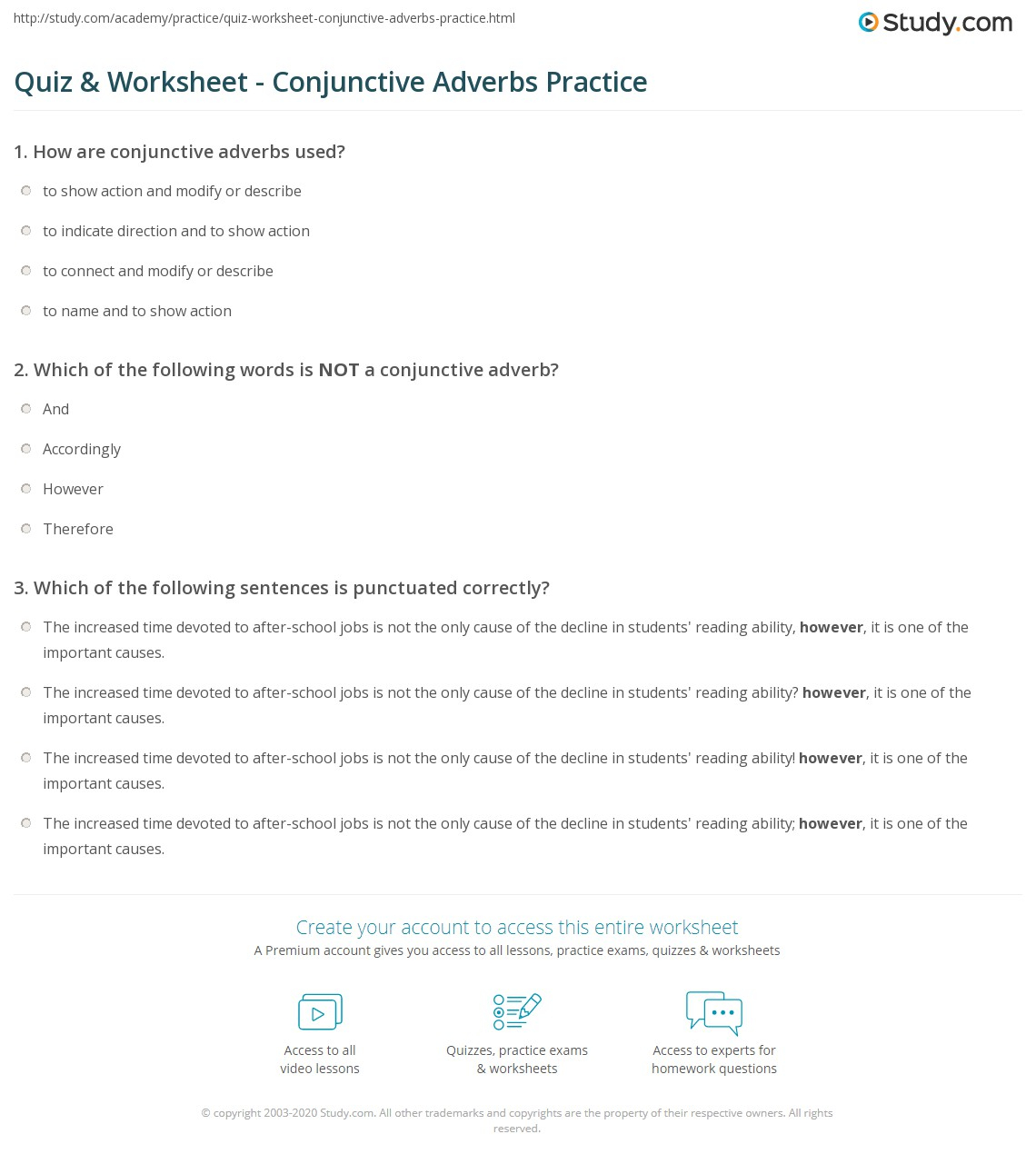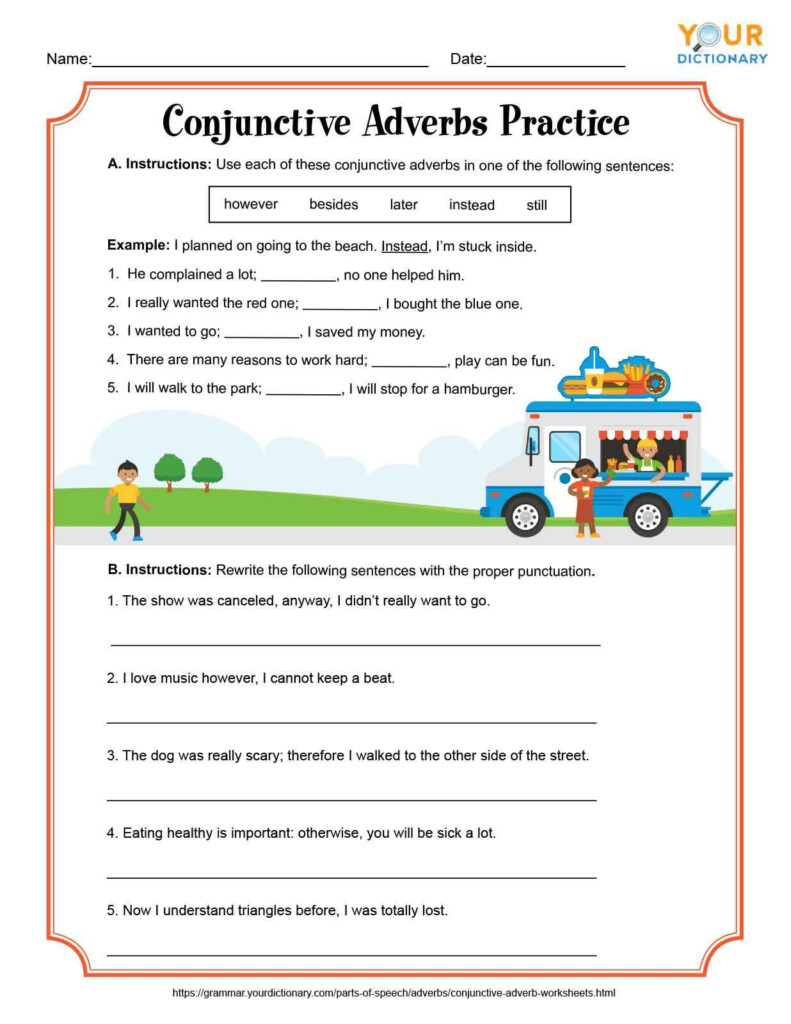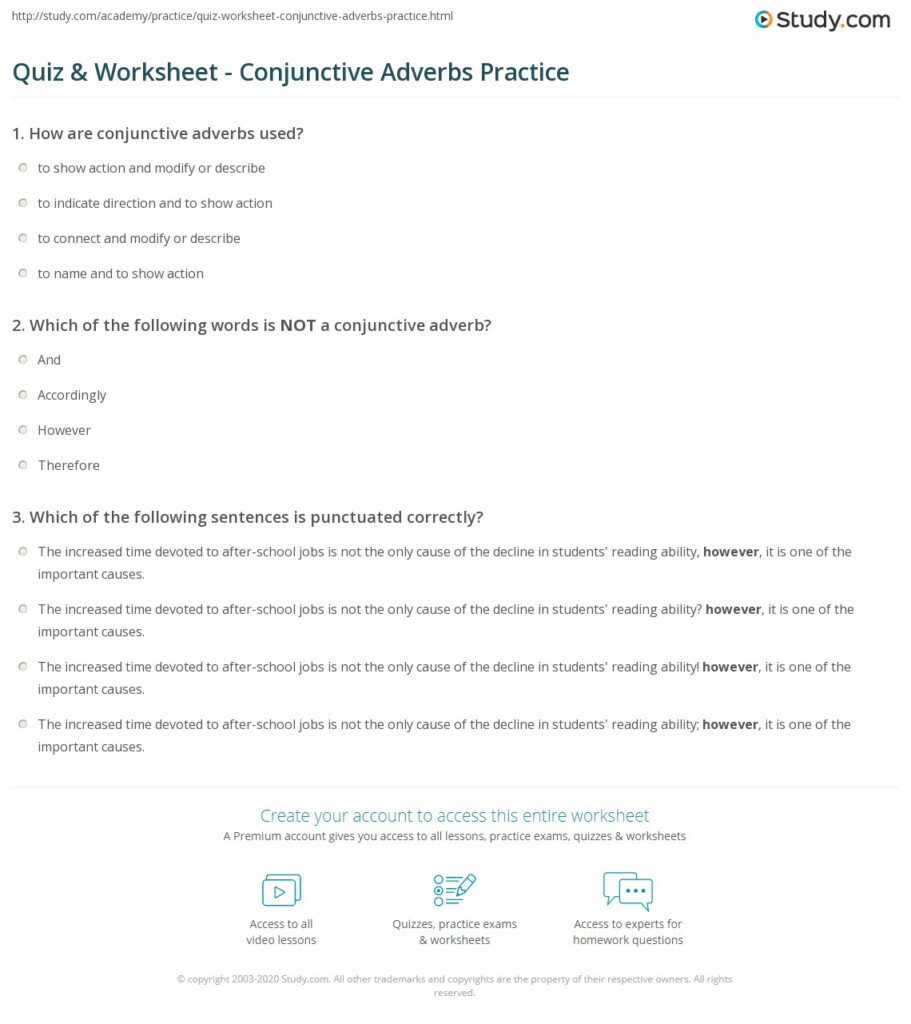Conjunctive Adverbs Practice Worksheets – Adverbs are words which describes a verb adjective, or another adverb. Adverbs are used to indicate the time and place they occurred. They are often placed before the adjective, verb or the adjective they alter.
Here are some examples:
He ran quickly.
She sang beautifully.
They can communicate fluently in English.
There are numerous ways to create an adjectival. There are a variety of methods to create adverbs. You can make other Adverbs through mixing words.
He drives slowly.
He was on time.
Adverbs can be placed at either the start or end a sentence. The order in which they are placed will depend on the purpose of the sentence.
As you can clearly observe, adverbs that modify verbs typically follow the verb. Adverbs that alter adjectives and other adverbs should be placed prior to the adjective or adverb they are modifying.
For example:
He is a slow-moving driver. (incorrect)
He is a slow driver. (correct)
He drives slowly. (correct)
They were there quickly. (correct)
They were there very quickly. (incorrect)
Let’s discuss the adverbs. These worksheets will help you to practice using the adverbs in sentences. The worksheets are divided into three sections including identifying adverbs and creating them.
It is essential to look over many sentences and then highlight the correct adjectives. The first section is focused on the identification of adverbs. The second section, focusing on Adverbs, will allow you to practice using adverbs for verbs and adjectives. The third part, forming Adverbs will teach you how to transform adjectives into adverbs.
Are you prepared to begin? Grab a pencil and start this adverb worksheet.
Adverb Worksheets: Types and uses
An adverb can be described as a word that refers to a verb, an adjective, or a different word. Adverbs are able to tell you when, where and how the action was carried out. For example, adverbs are typically placed after an adjective.
He moved slowly through the room.
You can create most adverbs by adding -ly to an adjective.
Adjective Slow
Adverb: slowly
Adjective: quick
Adverb: quickly
Adjective: hard
Adverb: Hard
An adverb can either be a one-word, or multi-word adverb. An example of a one-word adjectival is the –ly form.
He moved slowly throughout the room.
Multi-word Adverbs are made up of multiple words such as:
He was slow to move around the room.
These are a few common multiword adverbs.
adverb + adverb: quite slowly, extremely quickly
Adverb + adjective
Preposition + Adverb: Without delay, ahead
Two types of adverbs exist.
1. Adverbs that represent the way of life
The fashion adverbs tell us what is being accomplished. Here’s an example:
He moved slowly around the room.
The sentence below slowly demonstrates the movement of his body.
These are just some examples of adjectives that are used to describe the way things function.
Slowly, swiftly, calmly noisy, loudly and slowly
2. Place-related Adverbs
Place adverbs can be used to determine the exact location of something. Take this example as an example:
He moved through the room.
The adverb that is used in this sentence tells us the direction he been walking.
These are only a few examples of place adjectives:
Outside and upstairs, downstairs and everywhere else
Adverbs that describe frequency and time are available. Adverbs that define frequency and time are, for instance, a way to indicate when something was performed.
He walked slowly around the space.
This sentence makes use of the adjective slow.
Adverb Worksheets: Tips and tricks
Adverbs are the words that alter the meaning of a verb, adjective, or other adjectives. These worksheets can be used to educate your students on the various ways in which adverbs can be employed. These are some useful strategies and tips to maximize the use of the worksheets for adverbs.
1. There are numerous sentences that you can make.
You can use adverbs in a variety of sentence types. You should mix it up and use it along with your worksheets. Simple sentences are able to be paired with complex sentences, and even questions. This will make it easy for students to understand how to use adverbs in various situations.
2. Highlight using the adjectival
When you create worksheets, make sure you highlight the appropriate adverbs. This makes it easier for your students to identify the adverbs. Use only one color or an alternate color to signify every sentence.
3. Encourage your students to create their own sentences.
Students must be able to fill in the blanks on worksheets, but also create sentences using adjectival terms. They will be able understand how adverbs are used in writing.
Q&A on Adverb Worksheets
1. What are adverbs? And how can they be used?
An adverb describes an adjective, verb, or other word. Adverbs are used to indicate the time, place and manner in which something is performed. These often end with the -ly
2. There are four primary types of adverbs that can use.
There are four kinds.
3. How can I incorporate adverbs in my writing?
Adverbs are used to describe adjectives and verbs. Adverbs help create writing that is more engaging and descriptive.
4. What are some commonly used adverbs you use?
Common adverbs are: quickly, slowly; badly well; well; hard soft, early and late; never, always; frequently, but not always.






